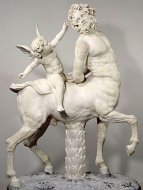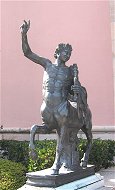Young CentaurMuseum Label: Chiurazzi description: Origin: Museo Capitolino, Palazzo Nuovo, Rome. |
Subject info:
The original "Furietti" old centaur and its companion (the young
Furietti centaur), kept at the Capitoline Museum and sculptured in Lucullan marble were
discovered in 1736 in the excavations carried by Monsignor Furietti at Hadrians
Villa. It is maintained by some art historians that these were copies
commissioned by Hadrian of earlier original bronzes from the eastern mediterranean.
| However, the provenance of the sculptures was highly distinguished and the Greek
inscriptions by Aristaes and Papias of Aphrodisias were indisputably genuine. Pope
Benedict XIV was said to have been so irritated by Furietti's refusal to present the
Centauri to the Capitoline Museum that he passed him over for a cardinal's hat, but much
later they were finally installed in the Vatican museum. It is generally accepted that in their original state the Furietti pair, like the Borghese sculpture (now in the Louvre- see pic on the right), would also have ben ridden by cupids, and were generally believed to symbolize the sexual desires which torment the old and delight the young. |
 |
Villa Hadriani. An estate of more than 30 buildings, including baths,
theatres, temples, libraries and audience halls, connected by a network of underground
service tunnels. Hadrian, a brilliant, complex personality, designed many of the buildings
himself. At 300 acres, the pagan emperor's residence was twice the size of the town of
Pompeii.
The grandiose palace estate was used by all subsequent emperors until Constantine –
who ransacked the villa for statuary and other valuables for his new city in the east. His
vandalism set an example for others to follow. With the arrival of the Christian Dark Age
the imperial residence became a quarry for stone, its beautiful marbles burnt for lime.
In the 17th and 18th centuries, European aristocrats – including the Popes – dug
several hundred buried works of art from the ruins to decorate their Renaissance mansions.
Many of the prized artifacts in the world's museums originally graced this sumptuous
palace of the caesars.
In contrast to the genuine imperial splendor of Hadrian, seven centuries after the death
of Hadrian, the Christian Emperor Charlemagne (Carolus Magnus), for all his pretensions,
ruled his ramshackle 'empire' from the ruins of the Roman spa town at Aachen. He liked the
thermal pools and quarried the ruins of the town to build a palace and a church.
The so-called "Carolingian Renaissance" is a fiction. The 7th/8th century
conquests of Islam isolated the Frankish lands from the civilizing influence of the
Mediterranean. Though Charlemagne styled himself "Roman Emperor and Augustus" in
reality he broke with Roman tradition.
Origin of centaurs:
The most common theory holds that the idea of centaurs came from the first reaction of a
non-riding culture, as in the Minoan Aegean world, to nomads who were mounted on horses.
The theory goes that such riders would appear as half-man, half-animal. (Bernal D az del
Castillo reported that the Aztecs had this misapprehension about Spanish cavalrymen.)
Horse taming and horseback culture evolved first in the southern steppe grasslands of
Central Asia, perhaps approximately in modern Kazakhstan.
The Lapith tribe of Thessaly, who were the kinsmen of the Centaurs in myth, were described
as the inventors of horse-back riding by Greek writers. The Thessalians tribes also
claimed their horse breeds were descended from the centaurs.
Of the various Classical Greek authors who mentioned centaurs, Pindar was the first who
describes undoubtedly a combined monster. Previous authors (Homer etc) only use words such
as Pheres (Beasts) that could also mean ordinary savage men riding ordinary horses.
However, contemporaneous representations of hybrid centaurs can be found in archaic Greek
art.
The armchair anthropologist and writer Robert Graves speculated that the Centaurs of Greek
myth were a dimly-remembered, pre-Hellenic fraternal earth cult who had the horse as a
totem. A similar theory was incorporated into Mary Renault's The Bull from the Sea.
The Greek word kentauros could be etymologized as ken - tauros = "piercing
bull". Another possible etymology can be "bulls slayer". Some say that the
Greeks took the constellation of Centaurus, and also its name "piercing bull",
from Mesopotamia, where it symbolized the god Baal who represents rain and fertility,
fighting with and piercing with his horns the demon Mot who represents the summer drought.
(In Greece, Mot became the constellation of Lupus.) Later in Greece, the constellation of
Centaurus was reinterpreted as a man riding a horse, and linked to legends of Greece being
invaded by tribes of horsemen from the north. The idea of a combined monster may have
arisen as an attempt to fit the pictorial figure to the stars better.
Alexander Hislop in his book The Two Babylons theorized that the word is derived from the
Semitic Kohen and Tor via phonetic shift the less prominent consonants being lost over
time ,with it developing into Khen Tor or Ken-Tor, and being transliterated phonetically
into Ionian as Kentaur.
